
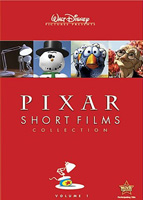 BUY IT AT AMAZON: CLICK HERE
BUY IT AT AMAZON: CLICK HERE
STUDIO: Disney
MSRP: $29.99
RATED: G
RUNNING TIME: 54 Minutes
SPECIAL FEATURES:
• A Short History of Pixar
• Director Commentaries
• Four Sesame Street shorts featuring Luxo Jr.
The Pitch
Everyone likes cartoons, even if they’re drawn by computers! Now give us thirty bucks.
The Humans
Director(s):
John Lasseter; Jan Pinkava; Ralph Eggleston; Pete Docter & Roger Gould; Bud
Luckey; Brad Bird; Mark Andrews & Andrew Jimenez; Gary Rydstrom
Actors: John Lasseter; Bob Peterson; John Goodman; Billy Crystal; Ralph Eggleston; Bud Luckey; Jason Lee; Bret ‘Brook’ Parker; Larry The Cable Guy; Owen Wilson; Paul Newman
The Nutshell
Pixar’s shorts are often as good as the company’s feature films; For the Birds, Geri’s Game and Lifted are ideal realizations of the basic ethos behind gag cartoons, while other shorts show off the company’s ever-evolving technical prowess. But of the 13 films here, only two are new to DVD. That makes this collection a poor proposition for Pixar completists, who should rankle at paying more than $15 MSRP for two new (and narratively unfulfilling) shorts and a few good special features.
The Lowdown
With two exceptions, the shorts on this disc can be grouped into two levels of quality, based on their date of creation. There’s the pre-Toy Story bunch, and those that came after Pixar’s first feature.
The first batch goes like this:
The Adventures of Andre and Wally B.; Luxo Jr.; Red’s Dream; Tin Toy; and Knick Knack.
While the other group includes:
Geri’s Game; For the Birds; Mike’s New Car; Boundin’; Jack-Jack Attack; One-Man Band; Mater and the Ghostlight; and Lifted.
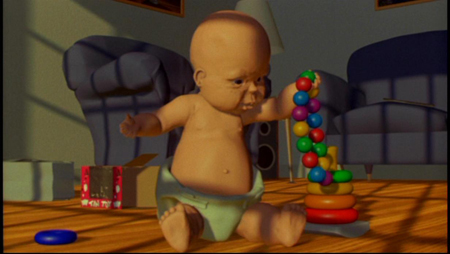
CHUD’s Forgotten Monsters Of Filmland: The Appendix #1
Of the first group, only Luxo Jr. and Knick Knack will satisfy an audience that wants to see something other than tech demos and a history lesson. Put into context, it’s impressive in abstract to know that The Adventures of Andre and Wally B. was made in 1984, but that doesn’t make it any more entertaining.
In general, Pixar’s formative efforts are more impressive as they draw a smooth curve up to the point of technical and artistic ability that enabled Toy Story and less so as pure entertainment. The humans in Red’s Dream and Tin Toy are overtly creepy. While Knick Knack is a cute piece of storytelling, it seems to be less visually impressive than Luxo and Red’s, almost as if John Lasseter had to choose between technology and narrative. (Actually, the limitations might also come from the fact that Knick Knack was made in 3D, though you won’t see it in that format here.)
Then there are the post-Toy Story shorts, which uniformly benefit from what the collective learned making previous shorts and that first feature. Even when the quality falters (as it does in two I’ll point out in a minute) all these films are better and more proficiently crafted than the early set.

One of Tony Scott’s True Romance climax animatics snuck in here.
Pixar’s ubiquity is so established that summarizing these films in depth seems absurd, so I’m going to keep this quick. Save room for the special features.
Geri’s Game is based on a questionable conceit: an old man playing himself at chess. But that conceit is wrapped around a perceptive vision of human behavior, like the inverse of a candy coating around an unpalatable pill. This is the trick that Pixar has been refining over the years, as they map authentic personalities onto abstract and sometimes wholly absurd story ideas.
For The Birds is much more direct as a large, goofy bird plops itself onto a wire laden with chirping, infighting little avians. Perfectly simple and direct, this remains one of the funniest films in Pixar’s list of accomplishments.
Mike’s New Car and Jack-Jack Attack are more like deleted scenes from their respective films (Monsters, Inc. and The Incredibles) and as such are directly tied to the appeal of those movies. I prefer Jack-Jack Attack since the sight of a baby tormenting his babysitter with unexpected and rapidly shifting powers plays to my base love of superheroes and old Marvel comics. Mike’s New Car is just as pretty as its parent film, but the jokes, drawn around impatient, irritable Mike’s experience with a complicated new ride, are almost too broad and silly.
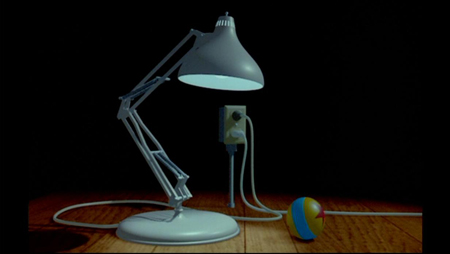
Pixar sells Prozac.
One-Man Band and Lifted are primo ‘modern’ Pixar, each showing off amazing CGI complexity without sacrificing story and character. Both are able to create fully drawn personalities with the ease of adding water to sea monkeys. One-Man Band satirizes big-studio film production as two multi-instrumentalists compete for audience attention with zazz instead of content. Lifted is a simple gag — an inexperienced alien being tested on his abduction abilities — in the vein of For the Birds, but with more depth and, for the running time, a greater density of gags.
The exceptions to the two groups are Boundin’ and Mater and the Deadlights. The former is an exceptional piece of animation and sports cute designs reminiscent of ’70s Disney animation. But the song which serves as the entire soundtrack is more obviously moralistic and preachy than anything else in the Pixar canon, making it dull to watch for those over ten. The latter is simply an extension of the relatively unappealing Cars. Put in context with all the other material here (and, by extension, with the time line of features this mirrors) Cars looks even more like a blot on Pixar’s resume. So Mater and the Deadlights, which vaguely cute, doesn’t stand up to the much stronger shorts surrounding it.
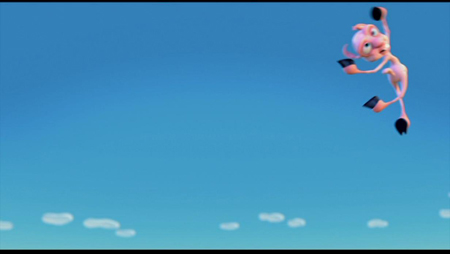
Naked Pink Sheep On Trampolines, Volume 17.
Finally, there’s one notable omission: Your Friend The Rat, which appears on the Ratatouille disc along with Lifted. The missing flick is one of Pixar’s best shorts, even though it’s reliant on the Ratatouille feature film; at least we know it’ll open Volume Two.
The Package
Try
not to be shocked at the paltry extras package. Each of the shorts, except for Jack-Jack Attack, comes
complete with commentary. I’m not sure if it’s more irritating that some
of the commentaries are identical to those on previous releases (Boundin’) or that some (Knick Knack) are new. The new ones don’t
always prevent outright duplication of the info in The Pixar Shorts: A Short History, either. Let that be enough to
truly bother if you like.
A Short History is good, if
accurately named at 23 minutes. The featurette covers the studio’s early days and
films up to Knick Knack before
jumping ahead to the attitude that keeps Pixar making shorts even as their
feature output has become massively popular and lucrative. It spreads attention around to far more people than John Lasseter, which is appreciated, and focuses on the interesting business decisions that led to Pixar (once a hardware company) making art instead of product.
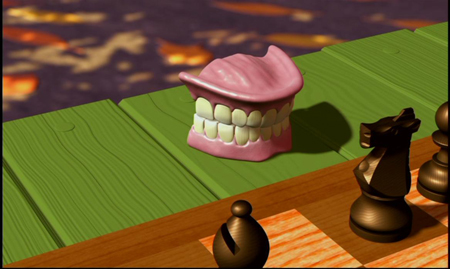
Richard Dreyfuss in Jaws: The Sunset Years.
Also
on deck are the four Luxo Jr. shorts produced for Sesame Street, albeit without commentary. Each is about a minute long and definitely for kids, as they introduce basic concepts like direction and weight. These look a bit worse
for wear than the rest of the content, which has been well mastered, but for
the sake of completion (and forced obsolescence of previous animation
collections) these are nice to have. Vaguely.
Looking
at this disc and Ratatouille side by side, what you realize is that Disney
decided to release a pair of stand-alone discs at thirty bucks each rather than
produce a double-disc set for Ratatouille featuring the previously unavailable
content you get here.
The Content: 9 out of 10
The Package: 2 out of 10